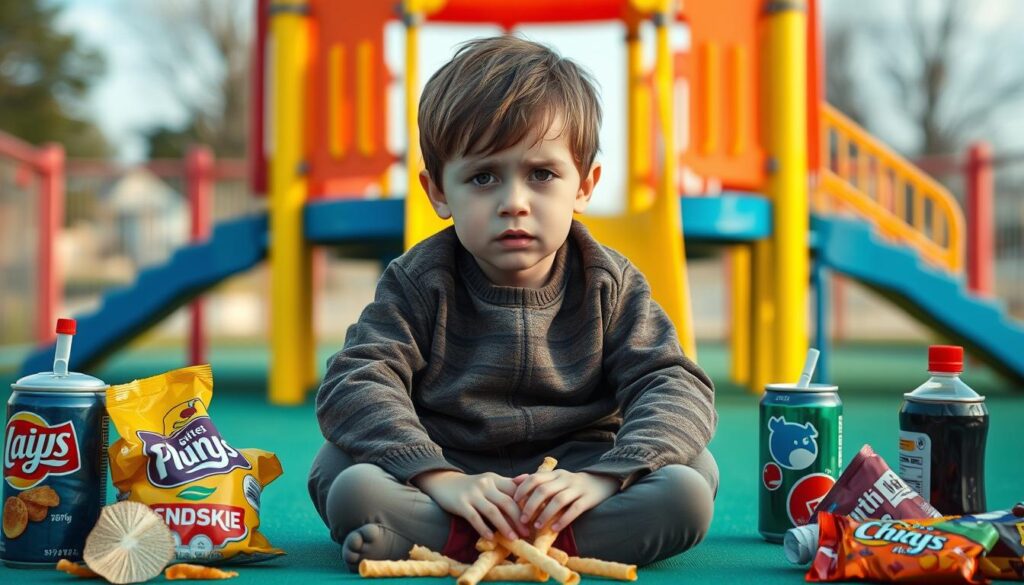In Australia, our children’s health is a big worry. Busy lives often mean kids eat poorly. We need to work together to help them stay healthy.
Childhood obesity is a big problem here. Kids eating too much junk food and sugary drinks is causing it. This can lead to serious health issues like diabetes and heart disease. It also affects their mood and how well they do at school.

Poor Eating Habits for Children: Health Concerns
Key Takeaways
- Poor eating habits among children in Australia have become a significant health concern.
- Childhood obesity is on the rise, driven by the overconsumption of unhealthy foods and beverages.
- Unhealthy dietary choices can lead to serious health issues, including type 2 diabetes, cardiovascular disease, and mental health problems.
- Addressing this challenge requires a multifaceted approach involving parents, educators, and healthcare professionals.
- Promoting better nutrition and healthier lifestyles among children is crucial for their overall well-being and development.
We need a big solution to fix poor eating habits in kids. Working together and teaching families can help. This way, we can ensure our kids grow up healthy and strong.
Poor Eating Habits for Children: Health Concerns And Childhood Obesity: A Growing Epidemic
In Australia, childhood obesity is a big worry. It’s caused by many things, like bad eating habits and not enough exercise. Genetics also play a part.
Contributing Factors and Consequences
Unhealthy food choices are a big problem. Kids are eating too much junk food and sugary drinks. This leads to weight gain and health issues.
Being overweight as a kid can lead to serious health problems later. Kids might get type 2 diabetes or heart disease. It also affects their mental health, causing low self-esteem and bullying.
Early Intervention Strategies
Good news: we can fight childhood obesity early on. Teaching kids to eat well is key. We should encourage them to eat healthy foods and avoid junk.
Getting kids to move more is also important. Schools and families can help by making exercise a part of daily life. This helps kids stay healthy and develop good habits for life.
“Addressing childhood obesity requires a comprehensive, multi-faceted approach that involves parents, educators, and healthcare professionals working together to promote healthy lifestyles and prevent the long-term consequences of this growing epidemic.”
Poor Eating Habits for Children
It’s vital for kids to eat well for their health and growth. But, many in Australia face challenges with their diet. They might eat too much junk food and miss out on important nutrients.
Picky eating is a big issue. Kids often don’t want to try new foods. This can mean they miss out on key nutrients, affecting their health and learning.
Another problem is addiction to junk food. Kids in Australia often prefer unhealthy snacks over healthy foods. This can lead to obesity and increase the risk of serious health problems later on.
Not getting a variety of foods can also cause health issues. Kids might not get enough iron, calcium, or vitamin D. This can slow down their growth and affect their brain function.
| Poor Eating Habit | Potential Consequences |
|---|---|
| Picky Eating | Nutrient deficiencies, stunted growth, and cognitive impairment |
| Junk Food Addiction | Childhood obesity, risk of chronic diseases, and poor overall health |
| Lack of Nutritional Diversity | Deficiencies in essential vitamins, minerals, and macronutrients |
It’s important to help kids make better food choices. The next parts will look at ways to encourage them to eat healthier.
Unhealthy Food Choices: A Gateway to Nutritional Deficiencies
In today’s fast world, kids often prefer unhealthy foods. They might choose sugary snacks or high-calorie meals. These choices can lead to childhood obesity and nutritional gaps.
Unhealthy food choices can cause nutrient deficiencies. Kids who eat too much junk food miss out on important vitamins and minerals. This can harm their growth, weaken their immune system, and raise the risk of chronic diseases.
| Nutrient Deficiency | Potential Consequences |
|---|---|
| Iron Deficiency | Anaemia, fatigue, poor cognitive function |
| Calcium Deficiency | Weak bones, increased risk of osteoporosis |
| Vitamin D Deficiency | Impaired bone health, increased risk of infections |
Junk food addiction makes it hard for kids to choose healthier foods. It’s important to break this cycle. This is key for kids’ health and well-being.
Teaching kids and families about healthy eating is crucial. It helps fight childhood obesity and nutrition gaps. A balanced diet supports kids’ growth and development, leading to a healthier future.
Picky Eating: Challenges and Strategies
Picky eating is a common problem in kids. It can be tough for parents and caregivers. Knowing why kids are fussy is the first step to solving it.
Understanding Fussy Eaters
Kids often avoid new foods because they’re cautious. This caution comes from their natural instincts. It can be made worse by things like sensory issues, how parents feed them, and eating disorders.
Understanding these reasons helps parents deal with picky eating better.
Encouraging Healthy Eating Habits
There are ways to help kids eat better. Start by slowly introducing new foods. Let kids help with cooking. Make mealtime a positive experience.
- Start with small amounts of new foods and be relaxed about it.
- Let kids help in the kitchen to make them feel involved.
- Make mealtime calm and free from distractions to help them focus on eating.
By understanding and tackling picky eating, parents can help kids enjoy a variety of foods. This can lead to a lifelong love for healthy eating.
Junk Food Addiction: Breaking the Cycle
In Australia, kids are eating more junk food than ever. This includes sugary snacks and salty chips. These foods are bad for their health and can lead to addiction.
It’s easy for kids to get hooked on junk food. Ads make it tempting, and it’s always there. This makes it hard for them to choose healthier options.
Junk food addiction is serious. It affects the brain like drugs do. The brain gets used to the high sugar and salt in these foods. This makes it hard for kids to stop eating them.
Practical Tips to Break the Junk Food Addiction
- Limit accessibility: Make junk food less available in the home, and encourage healthier snack options that are just as convenient.
- Educate and empower: Teach children about the importance of balanced nutrition and the negative impacts of excess junk food consumption.
- Lead by example: Parents and caregivers should model healthy eating habits, demonstrating that nutritious food can be just as enjoyable as unhealthy alternatives.
- Seek professional help: In cases of severe junk food addiction, seek the guidance of healthcare professionals or dietitians to develop a comprehensive plan for breaking the cycle.
We can help kids make better food choices. By tackling the reasons behind junk food addiction, we can guide them towards healthier eating. This sets them up for a lifetime of good food choices.
TO WATCH VIDEO CLICK HERE
“The path to breaking the junk food addiction starts with small, sustainable changes that empower children to make better choices.”
The Role of Parental Influence on Children’s Diets
As parents, we greatly influence our children’s eating habits. Our food choices and how we eat can shape their views on nutrition. This sets the stage for their eating habits for life. By understanding our influence, we can make our homes places where healthy eating is encouraged.
Setting a Positive Example
Children watch us closely and often copy what we do. When we eat well, they are more likely to do the same. Getting them involved in planning and making meals can make them feel more connected to their food choices.
- Lead by example: Ensure your own plate is filled with a variety of fresh fruits, vegetables, whole grains, and lean proteins.
- Make mealtime a family affair: Encourage your children to participate in the cooking process and learn about the importance of balanced nutrition.
- Avoid using food as a reward or punishment: This can reinforce unhealthy associations with certain foods and lead to poor eating habits.
By being a good example and teaching a healthy relationship with food, we help our kids make better diet choices. This can lower the risk of childhood obesity and poor eating habits that can lead to nutrition deficiency.
“The food we grow up with and the way we experience it as children can have a lifelong impact on our dietary preferences and health.”
Dietary Education: Empowering Children and Families
Starting a healthy relationship with food is key. We fight childhood obesity and nutrition gaps by teaching kids and families. Giving them the knowledge to choose well is vital for a lifetime of healthy eating.
Age-Appropriate Nutrition Education
Nutrition lessons should match the child’s age. Young ones learn about food groups, portion sizes, and healthy options. As they grow, they learn about nutrients, diet’s health effects, and mindful eating.
- Engaging, interactive lessons that capture the attention of young learners
- Hands-on cooking classes to develop practical skills in the kitchen
- Field trips to local farms or grocery stores to foster a connection with food sources
- Collaborative projects that encourage children to share their learnings with their families
Teaching kids about food gives them the knowledge and confidence. It helps them make choices that support their health, setting them up for a lifetime of good habits.
“Teaching children about nutrition is not just about imparting information; it’s about instilling a lifelong appreciation for the power of a balanced diet.”
With good dietary education in schools and at home, we help kids and families make better food choices. This leads to a healthier, brighter future for everyone.
School Lunch Programs: Promoting Healthy Choices
School lunch programs are key in the fight against childhood obesity and bad eating habits. They offer nutritious meals and encourage kids to make better food choices. This can greatly improve children’s diets and health.
These programs help limit unhealthy foods like sugary drinks and processed snacks. Instead, they provide fresh fruits, veggies, and whole grains. This change helps kids develop a taste for healthier foods.
But, starting these programs is tough. Schools must cater to different tastes and dietary needs. They need to make meals both healthy and tasty. This requires teamwork between schools, nutrition experts, and the community.
| Nutrition Indicator | School Lunch Programs | Home-Packed Lunches |
|---|---|---|
| Fruit and Vegetable Intake | Higher | Lower |
| Whole Grain Consumption | Higher | Lower |
| Calorie and Fat Intake | Lower | Higher |
The table shows school lunches can be healthier. Kids eat more fruits, veggies, and whole grains. They also eat fewer calories and fats than with home-packed lunches.
By focusing on nutritious school meals, educators and policymakers can fight childhood obesity. They can also teach kids to eat well for life.
Childhood Eating Disorders: Recognising and Addressing the Issue
Childhood eating disorders like anorexia, bulimia, and binge eating are serious and often missed. They can deeply affect a child’s health and happiness. It’s vital for parents, caregivers, and doctors to watch for signs and symptoms.
Anorexia makes people fear weight gain and see their bodies differently. It can cause severe weight loss and malnutrition. Bulimia involves binge eating followed by purging, like vomiting. Binge eating disorder is about eating too much without purging.
These disorders can be caused by many things, including poor eating habits for children, nutrition deficiency, and parental influence on diets. Early help and a team effort are key. This includes doctors, therapists, and family support to help children eat healthily again.
| Eating Disorder | Key Characteristics | Health Consequences |
|---|---|---|
| Anorexia Nervosa | Intense fear of weight gain, distorted body image, severe weight loss | Malnutrition, heart problems, osteoporosis, infertility |
| Bulimia | Cycle of binge eating and purging (e.g., vomiting, laxative abuse) | Tooth erosion, electrolyte imbalances, digestive issues, heart problems |
| Binge Eating Disorder | Recurrent episodes of uncontrolled overeating without compensatory behaviours | Weight gain, obesity, type 2 diabetes, high blood pressure |
Spotting the signs of eating disorders in kids is key. Look for big weight changes, food and body worries, and mood or behaviour shifts. A caring, all-around approach can help kids and families deal with these issues. This way, they can learn to have a good relationship with food.
“Addressing childhood eating disorders requires a compassionate, multidisciplinary approach that addresses the physical, emotional, and social aspects of the condition.”
Conclusion
As we wrap up our deep dive into poor eating habits in Australian kids, it’s clear we need a broad solution. Childhood obesity, nutrition gaps, and the dangers of bad diets are real. These issues affect kids’ health now and in the future.
Many things lead to these problems, like unhealthy food choices and junk food addiction. But parents play a huge role. By being good role models and teaching kids about food, we can help them eat better.
Schools also have a big part to play. They can offer healthier meals and teach kids about good food. It’s also key to help kids who struggle with eating disorders. This helps kids develop healthy eating habits.
“Good nutrition is the bedrock of child health and development. By prioritising the well-being of our young ones, we can build a stronger, healthier future for Australia.”
In summary, fixing poor eating habits in kids needs everyone’s help. Parents, teachers, doctors, and lawmakers must work together. With a solid plan, we can teach kids to make smart, healthy food choices. This will help build a better, healthier Australia for the future.
Additional Resources
We’ve looked into how poor eating habits affect kids, including obesity and nutritional gaps. There are many ways to help families, teachers, and doctors. They can work together to make sure kids eat well.
The Australian Government’s Eat for Health program has lots of tips on food for kids. It covers meal planning and getting kids involved in cooking. The Dietitians Association of Australia also has guides and support for better diets.
For more on why kids might not eat well, check out the Royal Australian and New Zealand College of Psychiatrists and the Australian Psychological Society. They talk about picky eating, junk food addiction, and stopping eating disorders. Talking to these groups can help tackle tough food and mental health issues.
TO SEE MORE TOPICS CLICK HERE
FAQ
What are the main health concerns associated with poor eating habits in children?
Poor eating habits in kids can cause many health issues. These include obesity, nutritional deficiencies, and stunted growth. They can also weaken the immune system and increase the risk of chronic diseases like type 2 diabetes and heart disease.
What are some of the key contributors to poor eating habits in children?
Several factors contribute to poor eating habits in kids. These include eating too much junk food and processed foods. Picky eating and not trying new healthy foods are also issues. The choices made by parents and peers also play a role.
How can parents and caregivers encourage healthier eating habits in children?
Parents and caregivers can promote healthy eating by being good role models. They should involve kids in cooking and introduce new, nutritious foods slowly. Creating a positive atmosphere during meals is also important.
What role do school lunch programs play in promoting healthy eating among children?
School lunch programs can greatly influence kids’ eating habits. They offer nutritious meals and encourage healthy choices. But, the success of these programs depends on the menu, food quality, and how much kids participate.
How can dietary education help empower children and families to make better food choices?
Dietary education, suitable for kids’ age, is key. It teaches the importance of a balanced diet and helps make healthier choices. It also builds a positive relationship with food for kids and their families.
What are the signs and symptoms of eating disorders in children, and how can they be addressed?
Eating disorders like anorexia, bulimia, and binge eating in kids need early action. Parents and caregivers should know the signs and symptoms. Seeking medical and therapeutic help is crucial to address these serious conditions.


